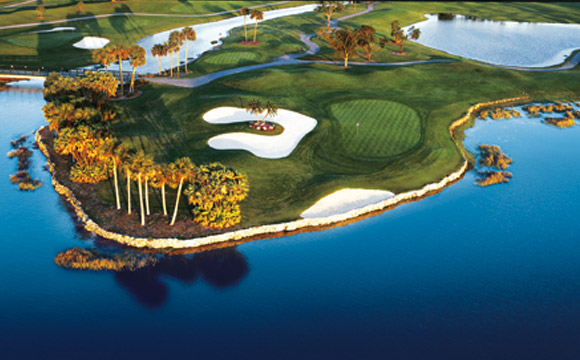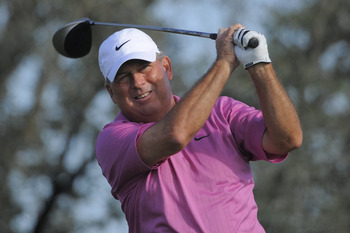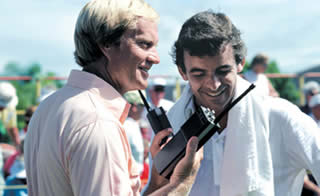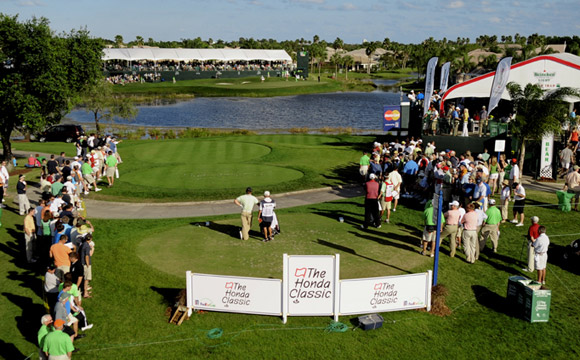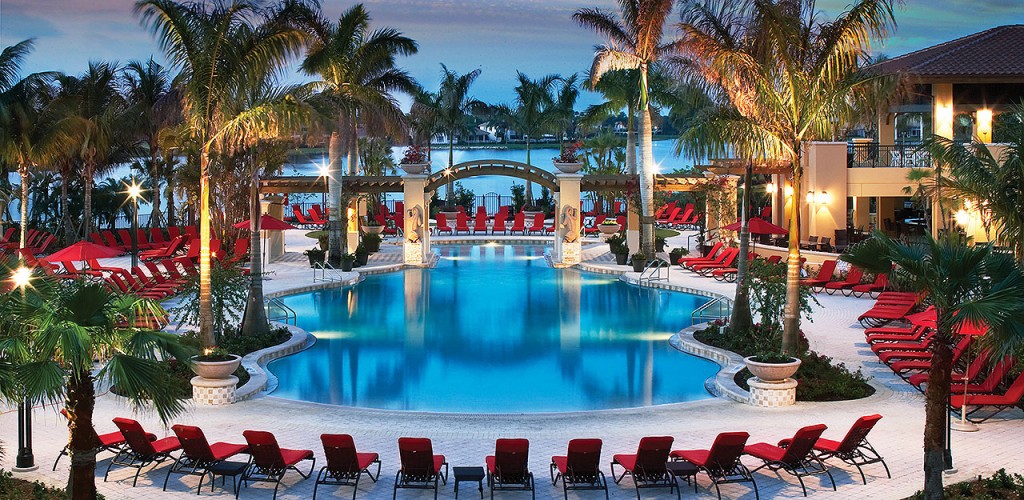 [The Bear Trap remains just as fearsome, but this piece first appeared in different form as a web exclusive in the June 1, 2012 issue of American Way, hence a few dated references.]
[The Bear Trap remains just as fearsome, but this piece first appeared in different form as a web exclusive in the June 1, 2012 issue of American Way, hence a few dated references.]
If PGA Tour pros start to quiver approaching the three-hole stretch called The Bear Trap at the Champion Course at PGA National, what prayer did I have? I’d shown up in Palm Beach Gardens with a bad back and a worse game to confront one of the toughest gauntlets in golf, where even the These-Guys-Are-Good brigade makes a hash of holes fifteen through seventeen each March.
At least I had no money on the line. A strong field of pros heads to Palm Beach Gardens each spring for the Honda Classic, the first stop on the Tour’s Florida swing, since its temptingly bulging purse makes it worth risking embarrassment or a round’s death by drowning at the notorious Bear Trap.
It takes playing them to understand how tough the watery three holes really are, but the number crunchers of the PGA Tour had concluded that, heading into the 2011 tilt, only one player had navigated the terrible trifecta under par in the four years the tournament had been held at PGA National: Luke Donald, at -1.
In 2011, the entire field went around in +1. Rory Sabbatini managed to do it in -1, and won the tournament. Meanwhile, 60 balls went in the water at hole fifteen, 25 at sixteen, 65 at seventeen, hence the joke that more balls are lost at the Bear Trap in one tournament than in an entire year at a sex-reassignment clinic.
It was not always thus. Putts starting flying across PGA National’s greens over 30 years ago, but the Champion course, originally a George and Tom Fazio design, was re-done by Jack Nicklaus in 1990 and again in 2002. The Bear Trap nickname derived from his Golden Bear moniker.
Nicklaus put more teeth into the Champion, but there was already plenty of golf history to chew on here, plus plenty to play with 90 total holes at PGA National Resort & Spa. The smorgasbord includes two other George and Tom Fazio tracks (the Haig, after Walter Hagen*, and the Squire, after Gene Sarazen), one by the King (the Palmer Course), and one by Karl Litton (the Estates). A PGA National Club Fitting Lab will put the right sticks into players’ hands, while a David Leadbetter Academy and a Dave Pelz Scoring Game School will show how to use them.
*Tom Fazio II did a complete renovation of The Haig course, which reopened as The Fazio Course.
The 379-room resort and communities nestled within the 2,300 acre sprawl includes a full-service spa, tennis courts, nine pools, one of the largest croquet courts in the hemisphere and meeting facilities all fresh off a $100-million revitalization. Seven dining options overseen by executive chef Gordon Maybury of Dublin are topped by the contemporary Ironwood Steak & Seafood. The iBAR watering hole right off the main lobby is enlivened by guests and locals at all hours–particularly so at tournament time–and where I was happy to see a nice selection of local craft brews on tap.

Back in the Day
Golf remains the beating heart at PGA National. Though there’s no strict relationship between the two, the PGA of America offices are here and some of its finest tournaments have played out over the Champion.
In this Ryder Cup year [2012] it’s worth recalling one of the most exciting, the 1983 thriller, pivotal in the history of the biennial competition. It capped a 26-year domination by the U.S. teams; after 1983 the European squad mounted a three-Cup win streak and took the trophy home nine out of the next 13 matches.
The 1983 U.S. squad was captained by none other than Jack Nicklaus, and by the time it was over he was brought to his knees–in a good way. Golf Hall of Famer Lanny Wadkins remembers it well, since the outcome hinged on a single shot in his penultimate singles match:
“It came down to the last two groups. I was playing Jose Maria Canizares and Tom Watson was playing Bernard Gallacher. And Watson was going to win.” Which meant it was up to Wadkins.
“The strange thing was that I felt I had outplayed Jose all day, but had nothing to show for it. It started right from the first hole, when he drove into the woods but wound up making a 60-footer while I missed a six-footer, so we tie the hole. On the eighth I had a 12-footer for birdie while he’s off the green with an impossible chip–but in it goes.”
Wadkins was down one at the par-5 last, needing to win the hole, halve the match and secure the Cup, with all his teammates watching. Canizares left his third shot short, leaving Wadkins to deal with an 82-yard wedge shot:
“It was huge, but I hit it a foot from the hole, and that was that. Tom Kite ran up and slapped me on the back; I turned to say something and nothing came out. That’s probably the most nervous I’ve ever been.”
Everyone else on the American side was jubilant. Nicklaus fell to his knees in the eighteenth fairway and kissed Wadkins’ divot.
Wadkins couldn’t, or wouldn’t, confirm the quote David Feherty attributed to him in his Totally Subjective History of the Ryder Cup. Supposedly Wadkins called his wife and said, “Wait a minute, Ethel, Jack Nicklaus is kissing a hole in the ground. The next thing you know it will be my ass.”
One of the more remarkable Hall of Fame careers belongs to Larry Nelson, who never even swung a stick in his youth. In August, when given the PGA Distinguished Service Award, Nelson reflected that, “I thought golf was a sissy sport.”
He changed his mind while serving in Vietnam, listening to incessant chatter about golf from fellow soldiers in the foxholes. Toward the end of his tour, he thought when he returned home he might start playing golf. Did he ever, relying on Ben Hogan’s Five Lessons: The Modern Fundamentals of Golf, and winding up with ten PGA Tour wins and three majors.
It’s 25 years since his 1987 PGA Championship win at PGA National, his victory coming on the first playoff hole–against Lanny Wadkins.
“It was deju vu all over again,” said Wadkins. “I was playing in the last group and if I birdie eighteen I win. I thought if I hit the same shot I did in ‘83 it would be perfect. But it was really, really hot that August, the greens were hard, and I left myself a 20-footer that slid past the hole.”
On the first playoff hole Nelson drilled in a six-foot par putt for the win, as Wadkins ran a four-footer past the cup.
Rearing Its Head
Both Nelson and Wadkins would go on to compete on the senior circuit and return to PGA National, home to the Senior PGA Championship from 1982 to 2000. Wandering the halls of the resort down toward the pro shop is a museum-like stroll with posters attesting to some of these memorable matches, and victories by the likes of Palmer, Player, Nicklaus, Trevino, Irwin.
The most light-hearted might be the 1987 win by Chi Chi Rodriguez. Trailing by six before the final round, Chi Chi strolled into the pro shop, bought a new set of clubs, and won by a stroke.
Trevino’s 1994 win came at the grisly (or grizzly) expense of Raymond Floyd, who had a four stroke lead in the final nine holes. Then he came to the Bear Trap. He rinsed two balls at fifteen for a quadruple bogey, and plunked another at seventeen for a double.
On the scorecard the Bear Trap doesn’t look that omnivorous–two par-3s around an average-length par 4. But approaching the fifteenth tee a player first sees an upright ursine statue, arms outstretched, mouth open. A plaque proclaims, “You are now entering The Bear Trap,” leaving the mind to supply the implied “Abandon all hope.” There’s also a prescient quote from Nicklaus: “It should be won or lost right here.”
Choosing the right tee box usually mitigates matters. The holes measure 179 yards, 434, and 172 from the back tees (I played them from 153, 391 and 155). But as Nicklaus says, distance isn’t the key factor:
“I don’t care if they make golf balls that go 5,000 yards. The Bear Trap will stand the test no matter what the equipment is, because they’re not holes you can overpower. It’s not about length, it’s about precision, and guts.”
For me, it was a case of nothing to lose: I’d already littered the opening nine with a string of double bogeys, but I heated up just as the course did. I wrassled the Bear Trap to the ground with a bogey and two pars, and felt triumphant enough to light a cigar.
No matter the tee, a player has a forced carry on fifteen. “When we put the water there it became a monster because of the awkward wind,” said Nicklaus, of a wind usually blowing right to left from the northeast. In 2010, this was statistically the toughest par-3 hole on the entire PGA Tour.
There’s water all along the right of the par-4 sixteenth as well, although it’s a greater factor on the second shot. A bold tee ball right can cut the distance to the green while flirting with a bunker. A safer shot left leaves a longer watery span to the dance floor.
The seventeenth is another pure carry with a yawning bunker left and nothing but water right. The bunker is hardly safe, since an aggressive explosion can fire a ball right into the drink. It’s pretty much hit the green here, take your medicine, or reload.
Fail or succeed here, the Bear Trap beckons for another go-round; isn’t hope one of golf’s redeeming qualities?
Ray Floyd found that out after his 1994 debacle, waltzing away with a five stroke win in the 1995 Senior PGA Championship. If terrorized by the Bear Trap the year before, Floyd had returned to tame it, turning it into a harmless cub.

